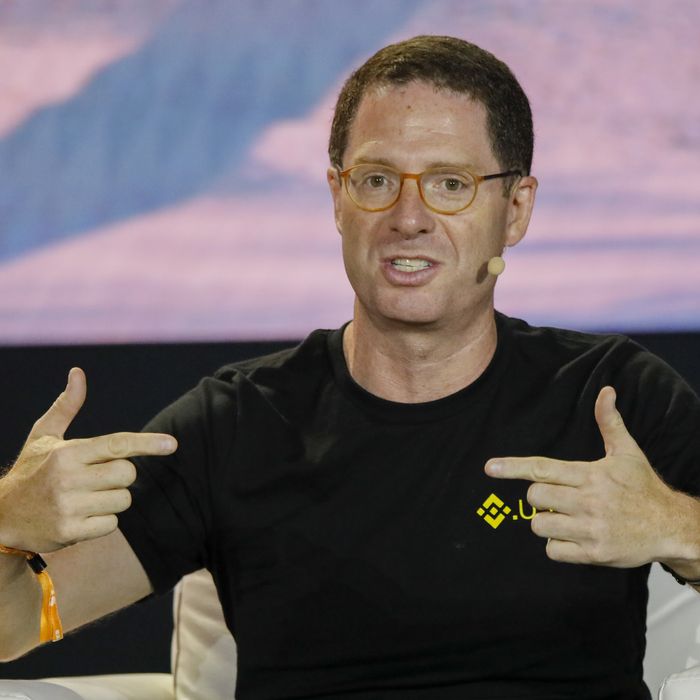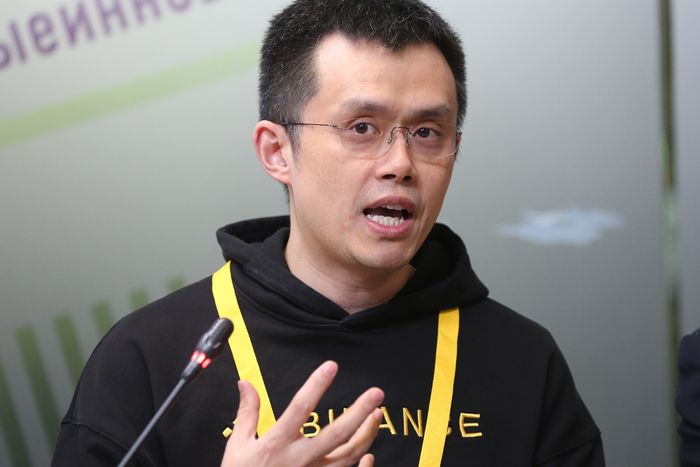
When the U.S. arm of Binance, the largest cryptocurrency exchange in the world, abruptly announced this spring that it had hired Brian Brooks as its new CEO, it appeared to be a huge win for the company.
Brooks was coming out of a term as the Acting Comptroller of the Currency, where he ran the federal agency that charters and regulates the country’s banks. He assumed that position after several stints at other regulatory bodies and as chief legal officer of Coinbase, the newly public crypto exchange. He was, in other words, exactly the sort of guy you’d want on your team if you were, say, girding yourself for an onslaught of increased regulatory scrutiny for crypto — which new Securities and Exchange Commission chair Gary Gensler seems to be telegraphing.
Binance is the giant in the crypto trading universe: With between $20 billion and $30 billion in transaction volume over a given 24-hour period, it dwarfs its next-largest competitors (Coinbase, by comparison, handles less than a fifth of that). This has made Binance’s founder and CEO, Singapore-based Changpeng Zhao (he goes by CZ ), a multibillionaire — not only one of the wealthiest and most powerful figures in the crypto industry, but arguably in global finance period.
So a heavyweight hire to oversee Binance’s growing U.S. operations made a lot of sense. Recruiting Brooks was such a coup that it was even easy to overlook what it meant for his predecessor, Catherine Coley, who was named CEO of Binance.US when it launched in late 2019. Coley, 32, had been the only woman to serve as CEO of a major crypto exchange, and with Brooks’s ascension, she seemingly was forced out. A young Wall Street transplant to crypto, Coley was an affable and outspoken evangelist not just for Binance.US, but for the digital asset industry as a whole, often tweeting analogies between crypto and basketball and punctuating her posts with exclamation points. But she had given no sign of resigning and the press release announcing Brooks’s hire made no mention of her, raising questions about whether she’d even been told before the announcement. She’d continued making media appearances in the days leading up to her ouster. Her last tweet was the day before the press release.
And then, on August 6, after just over three months on the job, Brooks followed her out the door: “Greetings #crypto community. Letting you all know that I have resigned as CEO of Binance.US,” Brooks announced on Twitter. “Despite differences over strategic direction, I wish my former colleagues much success. Exciting new things to come!”
If one CEO switch didn’t raise many eyebrows, a second in the span of a season certainly did — particularly considering Brooks’s robust bona fides in Washington. This time, no CEO was named to replace him, and a spokesperson for Binance.US declined to say whether the company would seek one at all.
“I remember I spoke to him after he got the job and he was very excited, and it sounded like he was really going to help put a strong regulatory compliant regime to Binance.US, and I think he had the full support of the board,” says Anthony Tu-Sekine, a Washington-based partner at law firm Seward & Kissel and head of its blockchain and cryptocurrency practice. “It’s certainly disappointing that his tenure ended so quickly … the first thought in my mind when I read about it was one of those, ‘uh oh, is the other shoe going to drop soon?’”
Before Brooks took the job, Binance was reportedly already under investigation by the Commodity Futures Trading Commission over whether it illegally allowed Americans to make certain trades on the exchange. In May, Bloomberg reported that the Justice Department and the IRS were also looking into Binance. In June, the U.K. banned the exchange, and in July, Thai regulators filed a criminal complaint. (Amidst all that, Binance’s chief financial officer, Wei Zhou, suddenly quit in early June, citing “personal reasons,” according to Coindesk.)
But Binance had launched its U.S. entity to hopefully address some of those concerns: As a foreign entity with no official headquarters, Binance can’t legally serve U.S. customers, in part because it offers trading in certain cryptocurrencies the SEC views as illegal securities (including XRP tokens from California tech company Ripple). Binance.US was designed to operate separately, serving American customers while listing a more limited set of digital coins. Still, Binance.US hadn’t escaped the authorities’ attention, and with the problems mounting, Brooks — well aware of the U.S. investigations when he took the job, according to a person familiar with the situation — faced a daunting mandate. “Many were surprised Brian didn’t leave sooner,” says Mike Alfred, an advisor and investor in crypto and tech startups who also co-founded Brightscope.
In a statement acknowledging Brooks’s departure, but stopping short of thanking him or wishing him well, CZ said, “I remain confident in Binance.US’s business. This transition will not impact Binance.US customers in any way.”
Behind the scenes, though, Brooks and CZ had butted heads in the days leading up to his resignation, according to a person familiar with the situation. Brooks had come to the job with a three-pronged plan to resolve the regulatory investigations plaguing Binance, focusing on separating Binance.US from its international sibling. The plan included raising a fresh round of venture capital and expanding the board of Binance.US, on which CZ served as chairman, with new, American members unaffiliated with Binance. In an interview with Bloomberg in May, shortly after he started, Brooks explained that his crucial task would be speaking to regulators to convince them of Binance.US’s renewed emphasis on legal compliance. “We are not an alter-ego of Binance,” he said in the interview.
Brooks quickly set his plan in motion. A pillar of his strategy was moving Binance’s technology — which the company was licensing to Binance.US before Brooks started — from Asia to the U.S. By late July, the transfer of the tech (controlling certain trading processes and other features) to U.S. servers was well underway, and Brooks was preparing to sever more of the overlapping relationship between his American domain and the international one CZ ran. “We’re already in the middle of that migration process. So, that relationship will go away relatively shortly,” Brooks told Forbes at the end of July.
The transfer was the final piece of the puzzle that Brooks believed would put Binance’s regulatory problems in the past. But in the early days of August, as Brooks finalized the plans for the transfer, CZ suddenly pulled the plug, the person said. The clash took colleagues by surprise; the day before Brooks resigned, Binance.US’s head of marketing, Graham Kahr, had been quoted lauding his boss in the New York Times, commenting, “Brian was a strong regulator who was tough on banks.” His strategy rejected, Brooks saw no path forward to resolving the company’s regulatory issues, and therefore, could no longer work there. So he announced his resignation August 6.
CZ told Intelligencer in a message that “That’s the wrong narrative,” but declined to clarify or comment on why Brooks left. He said Binance.US is still raising a venture capital round and diversifying the board, “as well [as] ensuring proper tech and data segregation.” A spokesperson for Binance.US, in a statement to Intelligencer, reiterated that the company “remains committed to its stated business plan,” listing the fundraising and board expansion — but did not specifically mention intentions to move Binance technology to the U.S.
Without a new leader for Binance.US and uncertainty over the investigations, some attorneys and crypto investors are bracing for potential regulatory penalties coming down the pike, though it’s unclear if Binance as a whole or the U.S. entity will be a target. Doug Schwenk, the CEO of Digital Asset Research, which vets and tracks exchanges to ensure they meet standards for institutional trading, says the company is monitoring Binance and Binance.US for new developments and potential government enforcement actions. “We require transparent leadership so we want to know who the new leadership is,” says Schwenk. “What we need to see is that Binance.US remains a separate business, run by a separate management team, and has different sets of compliance policies. So we are watching carefully to see what happens there.”
Brooks, meanwhile, will be fine. He’s already received dozens of job offers from crypto companies seeking his unique experience in the industry and at financial regulatory agencies.
The fate of his predecessor, Catherine Coley, remains a mystery though. Until recently, her social media bios still listed her as CEO of Binance.US. By the time Brooks arrived at the company, she was already gone. In July, a Decrypt article noted she had “effectively vanished.” She didn’t respond to multiple messages sent to her various accounts. She has a seemingly active Instagram, but it appears to be fake: The account’s first post, on May 31 — roughly six weeks after her ouster and a month after Brooks started — shows her wearing and holding a variety of Binance.US swag, including a branded bagel, and bears the caption: “Binance got it all 🥰✊ #dogecoin #coinbase #bitcoins.” The most recent post, a selfie of her in a neon leopard-spotted mask and a bitcoin t-shirt uploaded earlier this week, is the same one she originally posted to her Twitter feed in February. The number attached to the account, with a Washington state area code, rings until an automated message from Verizon says the call cannot be completed.
As for CZ, the search for someone new to lead his companies has been a hot topic of discussion for him lately — even before Brooks quit. But it wasn’t clear if CZ was seeking a potential replacement for Brooks, or for himself. After making a comment to press in late July that he was open to passing the baton to someone who could do a “better job,” CZ later clarified on Twitter that he did not plan to step down. “We would very much like to hire a strong compliance background CEO to show our commitment to compliance as this is the top priority of the organization,” CZ wrote on Twitter. “CEO contingency planning starts in day 0, same as any other role….We are always hiring for CEOs,” he added.
That’s certainly been the case lately.
"exchange" - Google News
August 17, 2021 at 11:00PM
https://ift.tt/3CVxY0k
The World's Largest Crypto Exchange Keeps Losing CEOs - New York Magazine
"exchange" - Google News
https://ift.tt/3c55nbe
https://ift.tt/3b2gZKy
Exchange
Bagikan Berita Ini
















0 Response to "The World's Largest Crypto Exchange Keeps Losing CEOs - New York Magazine"
Post a Comment